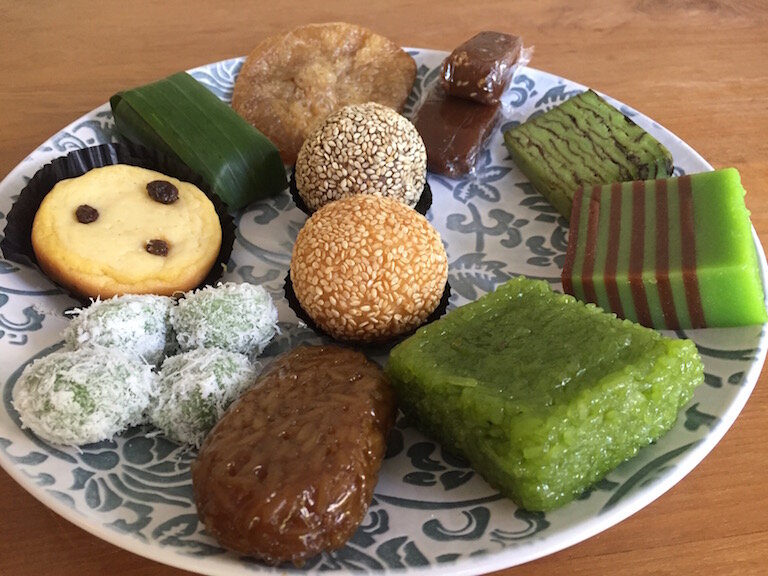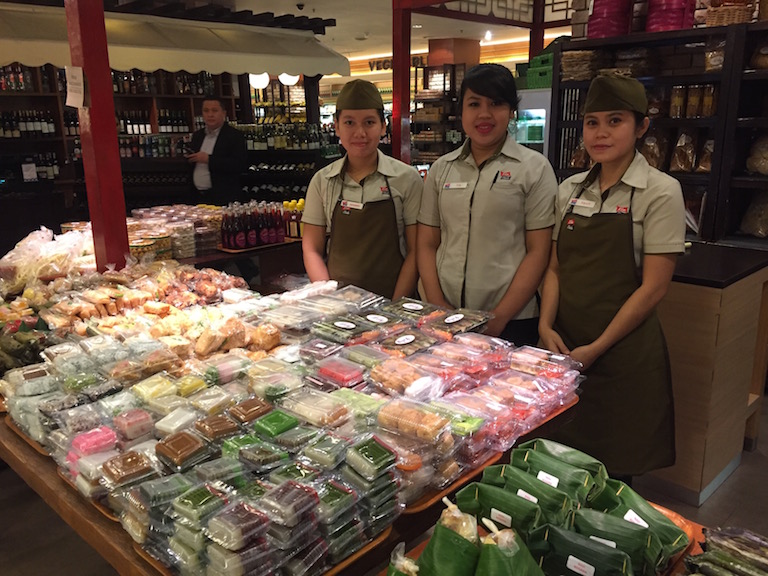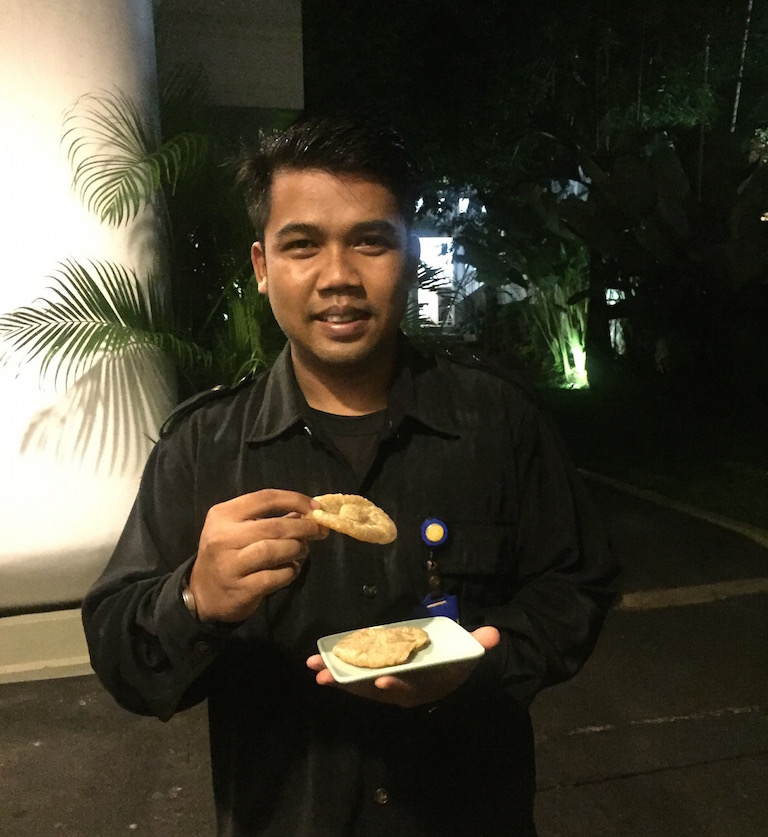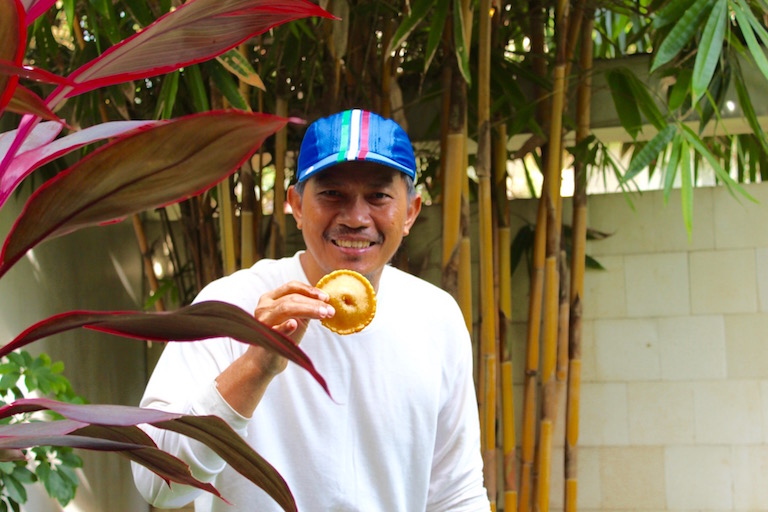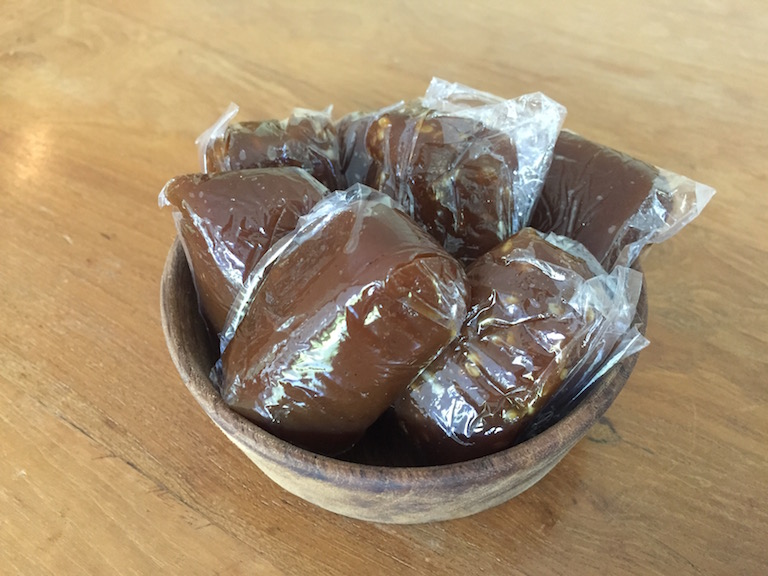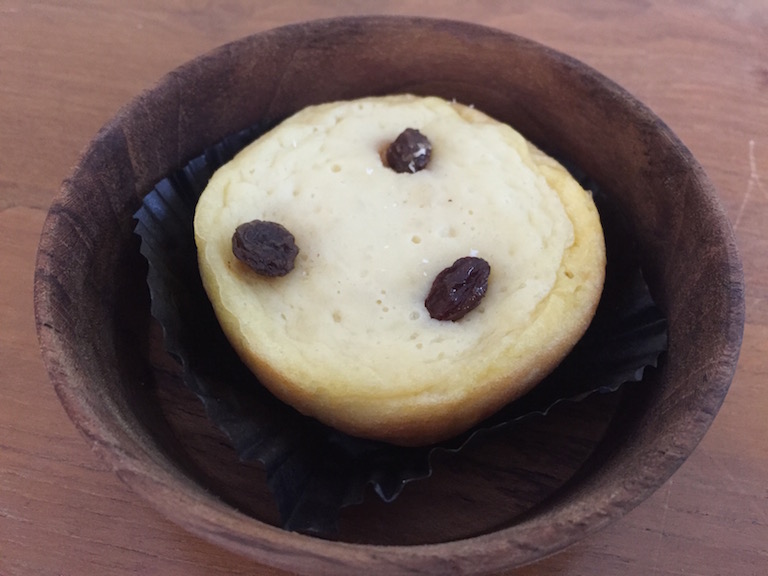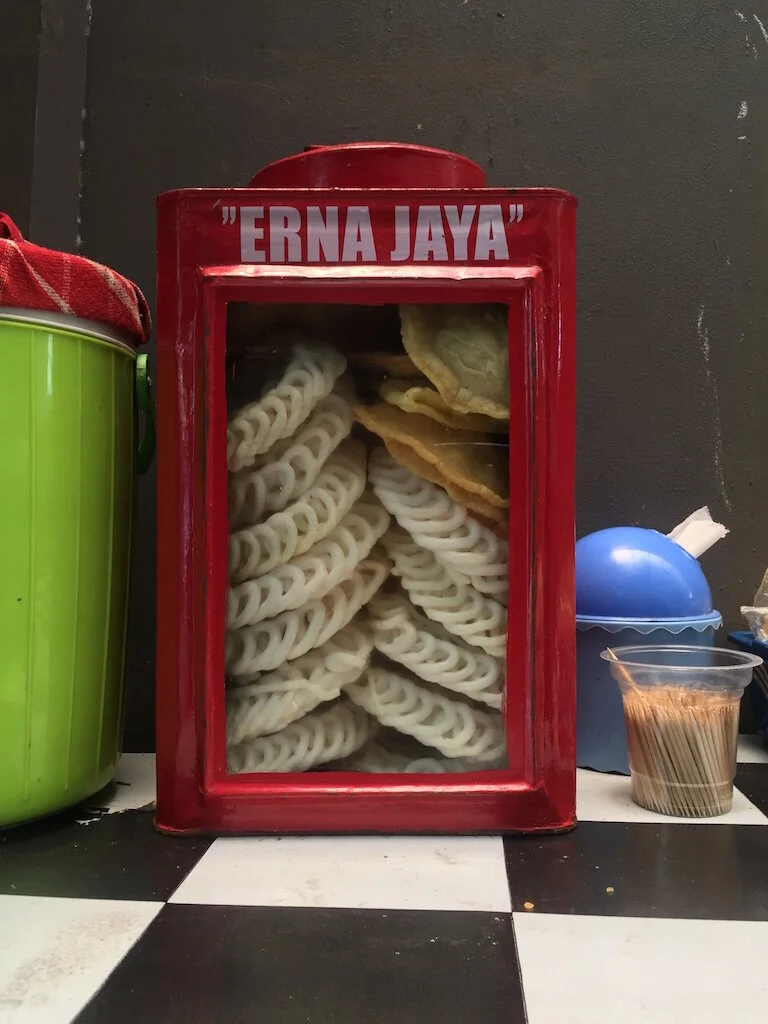Traditional Cakes and Sweets of Indonesia
Today's a journey bespoke post is all about Traditional Cakes and Sweets of Indonesia. We've shopped, tasted and researched more than 20 different sweets and can confidently recommend the following to you.
To share this blogging experience (and spread the calories around), we recruited the expert help of our household staff who eagerly informed us of their favourite cakes. It really has been a fortnight of Cake! Cake! Cake! Our pictures below tell the story of this sweet adventure!
Background to this story:
Jo's Story: In reality, the research behind today's story began at least 3 years ago when we started sampling these treats. Upon arriving in Jakarta, it soon became my afternoon tradition to head to my local supermarket (the one pictured above) and select at least 4 different cakes. I would then chop each one into bit-sized pieces and add them to our children's afternoon tea 'buffet' which they would demolish after a long day at school. The cake selection process was simple: choose ones that looked different from each other; make sure we hadn't tried them before (as there are so many to sample, repetition was not an option until we had exhausted all varieties) and ideally, cakes should coordinate well together to maximise the chance of the children trying them. So after almost 3 years of eating these delicacies, we can confidently share our favourites with you: Onde-Onde, Kue Wajik and Kue Bika Ambon. Enak sekali!!!
Liz' Story: Have I ever told you how much I love Martabak?
My introduction to Martabak catapulted me into the sweet, sweet world of ‘kue Indonesia’ 'Indonesian cake'
After enjoying Martabak Telur (a savoury pancake filled with spiced meat and egg), I was keen to experience the sweet version, Martabak Manis. My opportunity came during a weekend in Bandung, West Java. The local advice that I received lead me to Jl. Sudirman, a night market hotspot. One famous martabak outlet I visited that night had a waiting list two hours long, and a stream of motor cycle couriers collecting phone orders for delivery. The martabak I tasted was soft and fluffy and dripping with butter and jam; laden with calories I know, but the perfect late night snack as I explored the fresh food stalls that lined Jalan Sudirman Bandung. Martabak Manis continues to be my favourite midnight snack!
Which will be your favourite?
Kue Apem
Kue Apem is a traditional Indonesian cake made from dough that has been steamed. Kue Apem has a beautiful light texture, and sweet caramel flavour
Where is it from: Kue Apem or Kue Apam can be found throughout Indonesia in Jajanan Pasars (traditional markets)
Main ingredients: Rice flour, coconut milk, yeast and palm sugar. Kue Apem is usually served covered with grated coconut
Pak Ahmad Zainuri and his favourite kue, Kue Apem. Pak buys his favourite Indonesian snack Kue Apem from a neighbour who is a good cook. He loves the rich caramel flavour
Kue Bika Ambon
Kue Bika Ambon
Where is it from: Medan, North Sumatra (not from Ambon as the name suggests)
Main ingredients: Tapoica flour, eggs, sugar, coconut milk and yeast (which gives it its unique spongy texture)
Kue Bingka Ubi
Where is it from: This cake is popular with the Banjarese people of South Kalimantan. Its popularity has extended throughout the Indonesian archipelago and different varieties of Kue Bingka are also eaten in Singapore and Malaysia.
Main ingredients: Coconut milk, flour, eggs, sugar, vanilla, sweet potato and butter.
Other variations of Kue Bingka include banana, pandan, sweet corn and cassava.
Kue Cantik Manis
Kue Cantik Manis
Where is it from: Indonesia. Due to its pretty appearance, Kue Cantik Manis is especially popular with children.
Main ingredients: Coconut milk, flour, pandan, sugar, sago pearls (coloured)
Kue Cucur
Kue Cucur
Where is it from: Indonesia (but the most popular version of Kue Cucur is made by the Betawi people of Jakarta).
Main ingredients: Rice flour, palm sugar and coconut milk
Pak Depri enjoys Kue Cucur and is also particularly fond of martabak (both sweet and savoury types)
Pak Ramdani loves Kue Cucur. These simple pikelet-like cakes are a home-style favourite. Working nightshift, Pak Ramdani enjoyed his late night snack!
As you can see Pak Iwan is a fan of Kue Cucur! Pak buys from a Jajanan Pasar near his house in Depok and enjoys the sweet taste of palm sugar and this cake's interesting texture
Dadal Gulung
Dadal Gulung
Where is it from: Indonesia, especially popular in Java. Dada means ‘omlette’ or ‘pancake’ in Bahasa Indonesia and Gulung means ‘to roll’.
Main ingredients: Rice flour, eggs, coconut milk and pandan leaf to give the pancake its green appearance. Filling includes grated coconut and palm sugar.
An assortment of Indonesian Cakes and Sweets including Kue Cantik Manis (front left), Pandan and Chocolate varieties of Dadal Gulung (middle) and the colourfully layered Kue Lapis (centre front)
Dodol
Dodol
Where is it from: Dodol is a sweet confection popular throughout Indonesia but especially enjoyed during times of festivals including Eid-ul Fitr and Eid-ul Adha. The Betawi people of Jakarta pride themselves in making Dodol, and the town of Garut in West Java is the main production centre of Dodol in Indonesia.
Main ingredients: Coconut milk, *jaggery and rice flour. (It generally takes 9 hours of cooking time to make Dodol, with constant stirring required).
(*jaggery is the concentrated juice of dates, sugar cane or palm sap).
When asked what his favourite Indonesian sweet is, Pak Yusuf said without hesitation,'Dodol'. This locally made candy has a mildly sweet flavour with a slightly rubbery texture.
Kue Dongkal
Here are two delicious slices of Kue Dongkal, which in its complete form is approximately 20 cms in height and shaped like a cone. This delicious kue has a beautiful sticky caramel flavour combined with a dry steamed coconut texture
Where is it from: Kue Dongkal is a traditional snack of the Betawi people, the original inhabitants of the present day area of Jakarta
Main ingredients: Rice powder, sago, palm sugar, salt and water
Pak Heri is all smiles for Kue Donegal! Pak Heri buys his Kue Dongkal at a traditional pasar near his house and enjoys this sweet snack at work
Kue Klepon
Kue Klepon
Ibu Mina and her favourite kue, Kue Klepon. Ibu Mina loves the burst of sweet palm sugar that hits the roof of her mouth when she bites into kue klepon. Ibu Mina buys kue Klepon at a local street stall. She enjoys it as a snack to have at work or to share with her husband in the evening.
Where is it from: A traditional snack common throughout Indonesia
Main ingredients: Flour, rice flour, palm sugar, pandan paste, pandan leaf, grated coconut
Kue Lapis (steamed) and Kue Lapis Legit (baked)
Kue Lapis (steamed) and Kue Lapis Legit (baked)
Kue Lapis (steamed layered cake)
Where is it from: Kue Lapis Legit is found traditionally in Java. It developed during colonial times in the Dutch East Indies and may have been based on Dutch cake recipes using local ingredients. Lapis means 'layers' in Bahasa Indonesia.
Main ingredients: Kue Lapis Legit ingredients include: Butter, eggs, flour, milk powder, icing sugar and mixed spice or spekkeok powder. Kue Lapis Legit is a puffy layered cake, made from wheat flour and is baked, one layer at a time. In contrast Kue Lapis is a moist layered pudding, made of rice flour and sago, and is steamed.
Pak Faiz and his wife Ibu Ani are fans of Kue Lapis. Pak Faiz usually enjoys this snack on the weekend. Pak has just given up drinking coffee, but before that, he would always accompany Kue Lapis with black coffee
Lemper
Actually not a sweet at all, Lemper is a snack often filled with chicken or fish and folded in a banana leaf. Our staff like it so much, they wanted to include as one of their favourite snacks
Where is it from: Lemper is extremely popular throughout most parts of Indonesia
Main ingredients: Glutinous rice (cooked in coconut milk) which flattened into a layer and filled with shredded chicken, fish or ‘abon’ (meat floss). This is then wrapped in a banana leaf, ready for serving.
Lemper is a savoury snack consisting of rice filled with a savoury ingredient (usually chicken or fish and sometimes meat floss)
Pak Giman and his wife Ibu Tuti enjoy traditional Indonesian cakes and snacks. In particular, Pak Giman likes Lemper and Ibu Tuti enjoys the delicate flavour of Kue Lapis.
Kue Lopis
This beautifully packaged kue is Kue Lopis. It was lovingly made in a home in Kromat Jati a subdistrict of Jakarta Timur (East Jakarta) wrapped in banana leaves and tied up with twine. The twine keeps the kue package tightly wrapped, but also acts as a cutting mechanism, when you're ready to enjoy a slice.
Kue Lopis with accompanying bumbu, a mixture of shredded coconut and thick palm sugar to add flavour to the kue
Where is it from: Found in traditional markets and made by home cooks throughout Indonesia, but particularly Java. It has a special place in the homes of the Betawi people living in Jakarta and is often referred to as 'Kue Nenek' or 'Grandma Cake'
Main ingredients: Glutinous rice, shredded coconut, palm sugar syrup
As with western culture, cakes are often enjoyed accompanied by a hot drink. Pak Wahuydin set up this shot showing the way he likes to enjoy Kue Lopis. Kue and black tea!
Pak Wahuydin and his favourite local Betawi kue, Kue Lopis. Pak tells us this kue is 'terkenal!' 'famous' in Jakarta
Kue Lumpur
Kue Lumpur is a type of pudding
Where is it from: A traditional cake common throughout most parts of Indonesia
Main ingredients: Flour, coconut milk, mashed potato (or occasionally pumpkin), butter, sugar, eggs and vanilla
Kue Mangkok (cake bowl)
Kue Mangkok (Cake bowl) The texture is somewhat soft and firm and slightly moist.
Where is it from: Kue Mangkok is found throughout Indonesia, and is a traditional snack. The cake dough is placed inside a tin or cupcake container and then steamed until the top part of the cake rises, expands and blossoms like a flower.
Main ingredients: Flour, rice flour, tapioca, yeast, egg, coconut milk, sugar and salt
This is Pak Maryo and his favourite kue, Kue Mangkok. Pak Maryo buys his kue Mangkok at a Pondok Cabe street stall on his way to work. He enjoys this traditional sweet snack with teh manis (sweet tea) or simply with water
Kue Martabak
Liz' favourite Indonesian kue, Martabak Manis (may-nees; sweet). Martabak Manis resembles a crumpet, is cooked in a pan with yeast and shortening. The best part of purchasing this snack is you get to choose from a huge array of toppings (my favourite is always chocolate and nuts)! which when served straight off the pan, together melt into a gooey filling. What's not to love!
Where is it from: Found throughout Indonesia but particularly enjoyed in Jakarta and West Java
Main ingredients: Traditional Martabak Manis toppings include: roasted ground peanuts, chocolate sprinkles such as Ceres, condensed milk,cheese and chocolate.
Want to make delicious Martabak? Check out the recipe here!
Onde-Onde
Onde-Onde
Where is it from: Originally a sweet from China known as Jian Dui, Onde-Onde can be traced back to the Tang Dynasty of the 7th Century. Onde-Onde are fried pastry balls which are a popular snack throughout most of Indonesia. Their chewy and crispy texture is unusual and quite ingriguing, luring you back for another bite!
Main ingredients: Glutinous rice, mung bean (or lotus) paste, sugar, sesame seeds
Break through the chewy skin of Onde-Onde to reveal the bean paste
Pak Dila has two favourite local treats, or 'jajanan pasar': Onde-Onde (chocolate in this case!) and Dodol (especially the Betawi variety)
More cakes and sweets on offer at a local Jakarta supermarket
Kue Putu Ayu
Kue Putu Ayu is a steamed coconut cake coloured with pandan leaves and made in individual moulds
Where is it from: Kue Putu Ayu is a round cake with a hole in the middle found in traditional pasars and roadside stalls throughout Indonesia. In Jakarta, freshly steamed Kue Putu Ayu can be found at roadside stalls beginning at sunset and continuing to be sold throughout the night
Main ingredients: Fresh coconut, flour, sugar, eggs, pandan leaf, salt
Pak Juanda and his favourite kue, Kue Putu Ayu. Pak purchases his Kue Putu Ayu at a traditional market near his house at Pondok Labu. He loves the aroma of the pandan leaf that is used to colour the kue green. Pak also likes this kue because it is not too sweet.
Kue Serabi
Kue Serabi with durian sauce
Where is it from: Popular throughout most parts of Indonesia, in particular Java
Main ingredients: Flour, baking powder, sugar, eggs, coconut milk, syrup of palm sugar
Kue Serabi made with green pandan, accompanied with a traditional coconut sauce
Pak Kurniawan loves Serabi. He tells us that the best Serabi in Jakarta are sold by a local vendor just near his house. The Serabi are cooked using a wood fire which imparts a 'more delicious' flavour
Serabi are eaten with a special sauce poured over the top. Traditional sauce flavours include coconut and durian. Other options include chocolate and banana
Kue Singkong
Where is it from: Kue Singkong is found right across the archipelago as its main ingredient, cassava grows widely.
Main ingredients: This cake is very simple to make. The most time consuming part is the 1 hour of steaming it requires to achieve the chewy texture. Main ingredients include grated singkong (Cassava), agar-agar, water, sugar and grated fresh coconut for coating.
Want to make this delicious cake? Check out the recipe here!
Kue Talam
Kue Talam is made from cassava
Where is it from: All information found referring to Kue Talam was written in Bahasa Indonesia. And after scanning multiple articles, we were unable to confirm from where this cake originates. Needless to say, Kue Talam is sold widely throughout the pasars and local supermarkets of Jakarta.
Main ingredients: Rice flour, steamed sweet potato, palm sugar, tapioca, coconut milk
Kue Wajik
Varieties of Kue Wajik (the green one has been coloured with pandan and the colour of the brown one is due to palm sugar)
Where is it from: Java, Sumatra and Borneo (Malaysia). Kue Wajik has a cultural significance within the Javanese culture, especially during the Selematan ceremony (a communal feast in Java which symbolises social unity).
Main ingredients: Glutinous rice, palm sugar, pandan leaf (for flavour), coconut milk
An assortment of Indonesian cakes - Silakan! (Please help yourself!)
Unlike shops back home that sell mostly whole cakes, it is more typical to find local cakes and sweets for sale in snack-sized portions here in Indonesia. Local pasars as well as supermarkets have sections dedicated purely to these pretty treats. Each individual snack has been delicately wrapped in either banana leaf, plastic film or placed in plastic containers, ready for purchase. As you have seen, most are made from traditional ingredients and each is a work of art in its own right.
We love to hear from you! Have you tried any or all of the sweets featured above? Which are your favourites?
Let us know any cakes that we have missed and the ones that you recommend we try! Chat to us in the Comments section below.
Interested in other Traditional Foods of Indonesia? Check out these posts:
Krupuk and other Traditional Snacks of Indonesia
Tropical Fruits of Indonesia
How to Make Martabak
Ramadan and Eid ul Fitr (including recipe for Nastar biscuits)
Words: Jo Stevens & Liz McClean Photography: a journey bespoke


